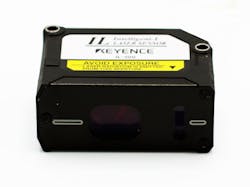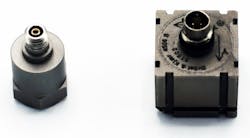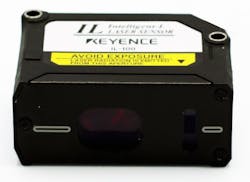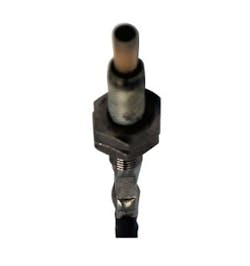What’s the Difference Between Vibration Sensors?
The ability to measure, monitor, and analyze vibration is essential to many industries and areas of research & development. Unfortunately, the proper methods for creating an accurate and repeatable vibration measurement system are not always clear to engineers unfamiliar with the nuances of test equipment and vibration analysis.
This three-part series offers the first-time vibration measurement system builder an overview of some of the challenges associated with vibration measurement, including proper component selection, signal conditioning, system configuration and setup, and waveform analysis.
Let’s start with the basics: Vibration is defined as oscillating motion about a position of equilibrium. Some common examples of vibration measurement include monitoring an electric motor, turbine, or bearing; health monitoring; and resonance detection.
Accelerometers are widely used to monitor vibration in aerospace, automotive, and manufacturing applications. Mechanical engineers often use them to diagnose problems with rotating equipment or assess the stability of structures that are subject to periodic stresses (such as monitoring the vibrations caused by trains/trucks crossing bridges, etc.). They are also often used in monitoring for condition-based maintenance, allowing engineers to examine the vibrations produced by a piece of equipment to assess its health, as well as to monitor the stresses sensitive equipment undergoes during transportation.
The most common method of acquiring vibration data involves connecting accelerometers and configuring them into a data acquisition system that can deliver high-resolution (24-bit) vibration data at very high sample rates. Modern data acquisition systems can plot, log, filter, and analyze vibration data in real time, and allow using a variety of accelerometer types. They can even allow for wireless streaming of vibration data over Wi-Fi if properly configured.
A variety of other tools and techniques are also available for vibration measurement, depending on the application.
Two accelerometers are pictured. The one on the left is a single axis, while the one on the right is a triaxial accelerometer. Accelerometers measure vibration and shock.
Selecting an Appropriate Accelerometer
As mentioned previously, accelerometers are the most commonly used sensor type for vibration measurement. When mounted directly on (or in) a vibrating structure, an accelerometer proportionally converts mechanical energy into electrical energy. Acceleration is generally represented with the gravitational constant g, which equals 9.81 m/s2. Three main types of accelerometers are used for vibration test:
Capacitive MEMS (micro-electro-mechanical systems) accelerometers are the smallest and least expensive accelerometer options, and are often used in smartphones. They can be mounted directly to printed circuit boards, which has made them electrical engineers’ preferred choice.
Although their low cost and small size have made them popular, they offer significantly lower data quality, especially on the higher frequency and amplitude end. They are generally unsuitable for industrial applications, but they are DC coupled and a great option for human-based applications. Their low cost and power consumption also make them a good choice for health monitoring.
Piezoresistive (PR) accelerometers produce resistance changes in strain gauges that are part of the accelerometer’s seismic sytem. They have a very wide bandwidth, which allows them to be used for measuring short-duration (high-frequency) shock events, such as crash testing. Because they measure down to 0 Hz, they’re useful for calculating velocity or displacement.
However, PR accelerometers typically have low sensitivity, which makes them less useful for high-accuracy vibration testing. PR accelerometers are also sensitive to temperature variations, so they require temperature compensation. They tend to be much more expensive than capacitive MEMS accelerometers, so they’re rarely used for lower frequency and amplitude testing. PR accelerometers are by far the best type for impulse/impact measurements where the frequency range and amplitude are typically high.
Piezoelectric (PE) accelerometers are the most popular and widely used for industrial applications. Their lead zirconate titante (PZT) sensing elements produce electric charge or output under acceleration. PE accelerometers have very low noise and offer performance superior to capacitive MEMS or piezoresistive accelerometers in all vibration and most shock applications.
Many variants are available: triaxial or single axis, from high sensitivity types for seismic applications down to low sensitivity for shock testing. Some PE types are designed to handle the most extreme environments—even nuclear ones. Their most significant downside is that they are AC coupled, so they can’t measure the gravity vector or sustained accelerations.
PE accelerometers are the foremost type for shock testing, but they are also preferred for vibration measurement. Because they are based on strain gauges, they require the use of amplifiers and temperature compensation; they offer very wide bandwidth (from 0 to several thousand hertz) and low noise characteristics. They can be gas or fluid damped, which protects the accelerometer and prevents it from reaching its internal resonant frequency. Because they are DC coupled, their output can be integrated to calculate velocity and displacement during shock events.
Charge mode piezoelectric accelerometers are extremely durable because of their ability to withstand hostile conditions, including extreme temperatures (−200°C to +400°C); some can even operate in nuclear environments. However, their high impedance requires the use of special cabling for noise shielding. A charge amplifier is also required, which adds to system cost and complexity.
Voltage mode Internal Electronic Piezoelectric (IEPE) accelerometers have become the most commonly used accelerometer type. They are very similar to charge mode piezoelectric accelerometers but include a built-in charge amplifier. That eliminates the need for special cabling and simplifies integrating them into a system. A constant DC power source is required, which many data acquisition systems now include.
The microelectronic circuit built into these accelerometers means they can’t match a charge mode accelerometer’s ability to tolerate hostile environments, but their typical temperature range of −40° to +125°C is sufficient for the majority of applications. As with any type of sensor, ensuring vibration measurement accuracy depends on choosing the right accelerometer for the specific application. In many cases, the accelerometer is the most critical link in the measurement chain.
For example, for shock testing that requires integrating the acceleration data for velocity or displacement, choose either a capacitive MEMS or piezoresistive accelerometer. Piezoelectric accelerometers are ideal for vibration measurement, but special high sensitivity accelerometers are needed for lower frequency applications.
A laser displacement sensor directly measures the displacement or position of any non-reflective surface.
Non-accelerometer Contact Vibration Sensors
An accelerometer is one type of contact vibration sensor, but there are several other types, including strain gauges. A strain gauge is essentially a foil with an electrically conductive grid. As the strain gauge is stretched or compressed, the electrical resistance of the grid increases or decreases proportionally.
The main advantage strain gauges offer is that they are versatile and accurate. They can be installed on virtually any surface and shape, and they measure both static and dynamic loads. They also measure strain directly, so that calculating the stress in the material is fairly easy.
Strain gauges are also very small and lightweight, so they don’t really alter the overall stiffness of the test specimen. Relative to other types of vibration sensors, they are inexpensive, ranging from just a few dollars for a basic one to a few hundred for very high-quality ones.
Their downside? They are difficult to install properly; strain gauges must be perfectly bonded to the material across the entire face to strain with the test article. Also, the electronics necessary to amplify the signal and acquire the data are costly (upwards of $10,000) and cumbersome.
Electromagnetic velocity sensors, although increasingly difficult to source, offer the advantages of measuring velocity directly and a very high temperature range. They operate by using the current generated from a magnet traveling within a coil.
In contrast with accelerometers, which measure linear acceleration, gyroscopes measure angular rate. Instead of an output expressed in g’s, the gyroscope’s output is a rate value, typically displayed as degrees per second (°/s).
Gyroscopes provide a frame of reference that is impossible to obtain with an accelerometer alone (or even a bunch of accelerometers). Accelerometers measure inertial forces, so they can help provide a frame of reference in relation to gravity, but that reference becomes difficult to maintain when the accelerometer is also vibrating. An accelerometer can also get “disoriented” during events with sustained static accelerations (like a banking aircraft) that can be misinterpreted as the gravity vector.
The gyroscope, however, allows the system to know the true course of motion. When used in conjunction with accelerometers, gyroscopes help keep track of the orientation of the system. Gyroscopes aren’t usually used alone for vibration measurement, but when paired with accelerometers, offer a much more complete picture of the vibrating environment.
An Eddy current sensor is a non-contact sensor which measures position or displacement changes of a conductive target/material.
Non-contact Vibration Sensors
Not all vibration sensors require direct contact with the source of the vibration:
Microphone or acoustic pressure sensor. Microphones offer a cost-effective way to measure high-frequency vibration and are especially useful to determine how a system’s vibration changes with time. Health monitoring applications can greatly benefit from using a microphone owing to cost and simplicity. Microphones can also provide a very clear and accurate representation of the frequency content in a vibration.
Laser displacement sensor. Laser displacement sensors use triangulation with a transmitting and receiving lens. A laser beam is emitted toward the target through a transmitting lens. The light then reflects back towards the sensor and is directed by a receiver lens to a receiving element. As the target moves closer and farther away, the angle of the reflected light changes (it’s focused on a different position on the receiving element).
Displacement sensors are preferable in applications that prevent the use of accelerometers, such as rotating components, or when the accelerometer’s mass would have too much influence on the motion of the system.
Eddy current or capacitive displacement sensors. These sensors have similar advantages and disadvantages as lasers for vibration measurement. Although they offer a way to “measure vibration through the air” without altering the vibrating system, they can only measure relative motion; they need to remain fixed and measure the difference in motion of a nearby structure. As a result, they are best used only in the lab, given the fragility of the test system (expensive sensors, wiring concerns, and power supplies).
In Part 2 of this series we will address signal conditioning, as well as choosing and configuring the data acquisition hardware for a vibration measurement system.
Stephen Hanly is vice president of sales & marketing for Midé Technology Corporation.




